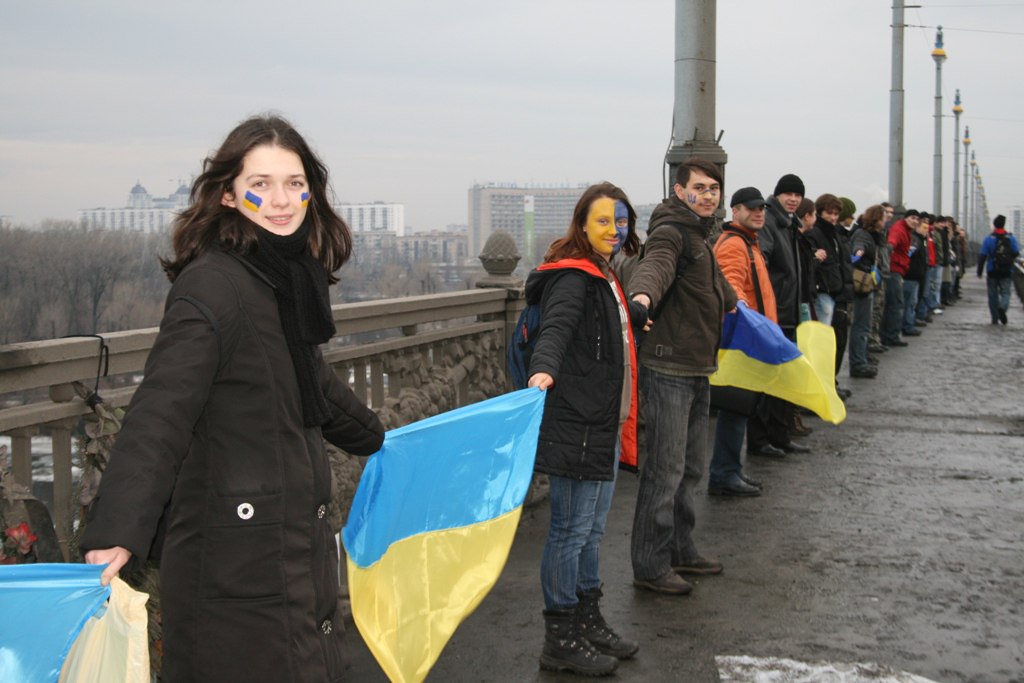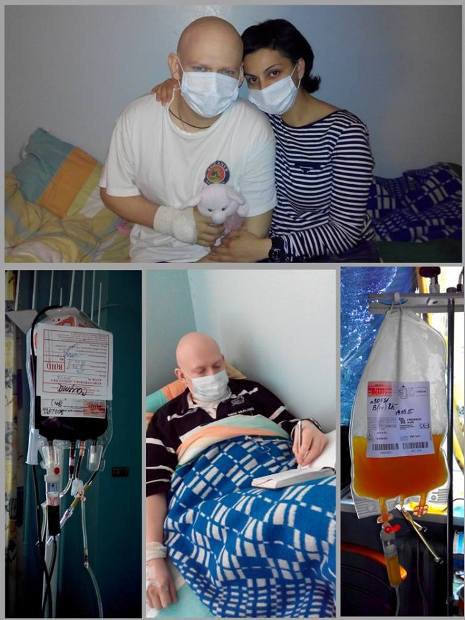Anyone who supports Ukraine and desire its unity and cessation of the Russian aggression can participate in this action being organized by the youth organization Batkivschyna Moloda and the NGO Ukrainians.
Print out or recreate the poster with the motto of the action: “United Ukraine”. Posters can be downloaded in Ukrainian here or in English here.
Take a photo with the poster, horizontal orientation and with one person in the photo.
Publish the photo on the official Facebook page of the flashmob and on your own social network pages using the hashtag #UnitedUkraine, and including the city and country in which the photo was taken.
Send the photo in high resolution electronically no later than Thursday, 21 January 2017, to [email protected] or [email protected].
This year the organizers expect to involve people from about 200 towns and cities of Ukraine and more than 40 countries. In 2016, more than 15,000 participants from 68 countries and 117 towns and cities joined the action.
What the Act of Unity is about
Around three million people in Ukraine took each others hands and connected Kyiv and Lviv via a real human chain. It was 22 January 1990 when Ukrainians, still being a part of the Soviet Union, marked the 71st anniversary of the Unification act of the Western Ukrainian People’s Republic and Ukrainian People’s Republic, the fledgling independent states that appeared after the fall of the Russian and Austro-Hungarian empires. Unity was a dream of many generations of Ukrainians who throughout centuries were engulfed by different empires on their borders.

A human chain connects Ukraine’s capital, Kyiv, and its Western city of Lviv on 22 January 1990
This chain has been one of the largest in the world’s history and became a significant step towards Ukraine’s Independence. To understand what the Act means for Ukrainians, one needs to recall the historical context in which it was signed. Then, Ukraine was in even worse conditions than now: it experienced aggression not only from the side of Russia but also from its western neighbors.
West Ukrainian People’s Republic
On the eve of the World War One, a large part of the territories of modern Ukraine, in particular, eastern Galicia, Bukovyna, and Transcarpathia, were part of the Austro-Hungarian Empire.
In October 1918, the Empire ceased existing because of the defeat of Austro-German bloc in the War and because of the struggle of nations that were part of it for their independence.
Western Ukrainians also started creating the own state. In the end of 1918, a military commissariat was established in Lviv to plan a military uprising against the Austrian government. On 18 October 1918, in Lviv at the meeting of all Ukrainian deputies of Austrian Parliament, Ukrainian members of Galicia and Bukovyna Seims, representatives of the parties of Galicia and Bukovyna, clergy and students created the Ukrainian National Rada (a Council) which became a political representative body of Ukrainian people in Austro-Hungarian Empire. In October 19, according to the right of people to self-determination, the Rada claimed the creation of a Ukrainian state on all ethnic territories of Galicia, Bukovyna and Transcarpathia. On this meeting, Yevhen Petrushevych was appointed as the President, and the decision to create a democratic constitution was made. The Rada also raised the question on giving all the power to Ukrainians, however, the Austrian side rejected it.
Then, on the evening meeting of 31 October 1918, a decision to seize power in Lviv in a military way was made. Rifle regiments captured the buildings of important state institutions. A temporary body of executive power was created, and the law on “The basic temporary law on state independence of Ukrainian lands of ex Austro-Hungarian Empire” was approved. According to this law, the new state was called Western Ukrainian Peoples Republic (ZUNR), which included Ukrainian ethnic lands and covered Galicia, Bukovyna, and Transcarpathia. The population of the state was 6 million people. National symbols also were approved and the main law later was complemented by the number of laws directed on political and economical aspect of life of the new republic.
As a result of active foreign policy, embassies were opened in Austria, Hungary, and Germany and diplomatic representations were opened in Czechoslovakia, Canada, USA, Brazil, Italy and others.
However, the movement of the new republic towards independence was interrupted.
The Poles initiated hostilities against the Ukrainian government. Simultaneously, Romanian troops crossed the border of ZUNR. As a result, despite the local population’s resistance, Romanians captured the city Chernivtsi and later all South Bukovyna. After bloody battles, Polish troops captured Lviv. Ukrainian Government moved to Ternopil, and later to Ivano-Frankivsk (then, the city was called Stanislav). A new government headed by Sydir Golubovich was formed.
Ukrainian People’s Republic
Ukrainian Peoples Republic (UNR) is the name of the Ukrainian state during 1917-20 years.It was declared by the Third Universal of Ukrainian Central Rada (council). In the circumstances of military aggression of Bolshevist Russia, Ukraine’s Central Rada declared the independence of UNR as a free sovereign state. According to the third Universal, the republic included Kyiv, Podil, Kharkiv, Katerynoslav, Kherson and Tavr (excluding Crimea) gubernies, the administrative units of that time.
The highest legislative body Ukrainian Central Rada was headed by the president Mykhailo Hrushevsky. The new Republic was facing the obstacles on the way towards it’s development, the main one being aggression of Bolshevist Russia.
One important diplomatic action of UNR was signing the Brest Agreement in February 1918 with the countries of Quadruple Allianceб which defined UNR as an independent state. It was also recognized by Romania. The new republic opened embassies in Berlin, Constantinopol, Vienna, Sofia, and Bucharest. Also here, national symbols and currency – hryvnia, the same currency as in modern-day Ukraine, were introduced. Ukrainian Central Rada elected the president – Mykhailo Hrushevsky, and the constitution was adopted. However, at that time Ukraine was plagued by an internal power struggle. In April 1918, the Central Rada was removed from power by the Ukrainian Congress of Farmers and Petro Skoropadskyi was elected as the new Hetman of Ukraine. As a result of anti-hetman uprising in 1918, UNR was replaced by the Directoria.
The Act of Unity
People gathering to support the Act of Unity in 1919, Sophia Square, Kyiv
The authorities of ZUNR considered the unity with UNR as the main state priority. This position was supported by the population. Ukrainian Central Rada sent its representatives to Kyiv to talk to the Hetman Petro Skoropadsky. After the beginning of anti-hetman upheaval, the negotiations were conducted with the Directoria. A Preliminary agreement on Unity was signed at the end of December 1918.
In 22 January 1919, the Act of the Union claimed that UNR and ZUNR are united in one independent state. It was stated in the Universal that this state includes Galicia, Bukovyna, Hungarian Rus and Central Ukraine. At the same time, on Sofia Square in Kyiv, the delegations of the both republics read this decision to people.
The decision was not implemented in practice because of martial law. Later, it also became clear that the two republics have different strategic visions. However, from today’s perspective, the Union had a significant meaning for Ukraine and for its people, showing that for a long time Ukrainians were struggling to be united, not separated.
In 1990, Ukraine celebrated its largest Act of Unity; nowadays, each year activists in Ukraine recreate the event. In Kyiv, people usually link the two banks of the Dnipro river with a human chain on the bridge of Paton. The place is symbolic as it unites the right and the left sides of Dnipro river which divides Ukraine roughly into two. The largest event there took place in 2011, when over 1000 people came to the bridge. Also that year people from more than 20 cities created human chains.

Now, in a time when Ukraine is struggling for peace and unity once again, any actions of support of its independence mean a lot to Ukrainians.








